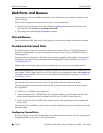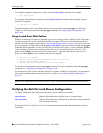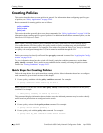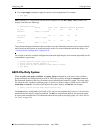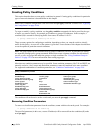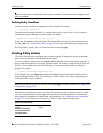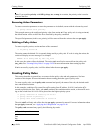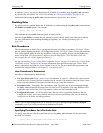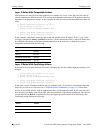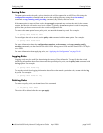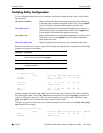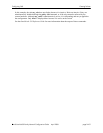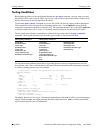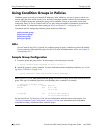
Configuring QoS Creating Policies
OmniSwitch 6600 Family Network Configuration Guide April 2006 page 24-27
In addition, a policy rule may be administratively disabled or re-enabled using the policy rule command.
By default rules are enabled. For a list of rule defaults, see “Policy Rule Defaults” on page 24-10.
Information about using the policy rule command options is given in the next sections.
Disabling Rules
By default, rules are enabled. Rules may be disabled or re-enabled through the policy rule command using
the disable and enable options. For example:
-> policy rule rule5 disable
This command prevents rule5 from being used to classify traffic.
Note that if qos disable is entered, the rule will not be used to classify traffic even if the rule is enabled.
For more information about enabling/disabling QoS globally, see “Enabling/Disabling QoS” on
page 24-13.
Rule Precedence
The switch attempts to classify flows coming into the switch according to precedence. For Layer 2 flows,
the rule with the highest precedence will be applied to the flow. For Layer 3 flows, all rules that match the
flow will be applied unless the rules are in conflict; if rules are in conflict, the rule with the higher prece-
dence will be used. (This functionality is different from the OmniSwitch 7700/7800/8800, which will
always apply the rule with the highest precedence.)
See the next sections (“Layer 3 Rules With Compatible Actions” on page 24-28 and “Layer 3 Rules With
Conflicting Actions” on page 24-28) for more information about precedence and Layer 3 flows. Prece-
dence is particularly important for Access Control Lists (ACLs). For more details about precedence and
examples for using precedence, see Chapter 25, “Configuring ACLs.”
How Precedence is Determined
Precedence is determined by the following:
• The type of QoS rule (Layer 2 source, Layer 2 destination, or Layer 3)—When a flow comes into the
switch, the Layer 2 source rules are examined first for a match. If no match is found, the Layer 2 desti-
nation rules are examined. If no match is found, the Layer 3 rules are examined.
• Precedence value—Each policy has a precedence value. The value may be user-configured through
the policy rule command in the range from 0 (lowest) to 65535 (highest). (The range 30000 to 65535
is typically reserved for PolicyView.) By default, a policy rule has a precedence of 0.
• Configured rule order—If a flow matches more than one rule in a particular precedence list (for
example, the Layer 2 source list), and both rules have the same precedence value, the rule that was
configured first in the list will take precedence.
Note. If you configure bridged traffic to be classified as Layer 3 (through the qos classifyl3 bridged
command), Layer 2 ACL rules are effectively disabled for IP traffic.
Specifying Precedence for a Particular Rule
To specify a precedence value for a particular rule, use the policy rule command with the precedence
keyword. For example:
-> policy rule r1 precedence 200 condition c1 action a1




